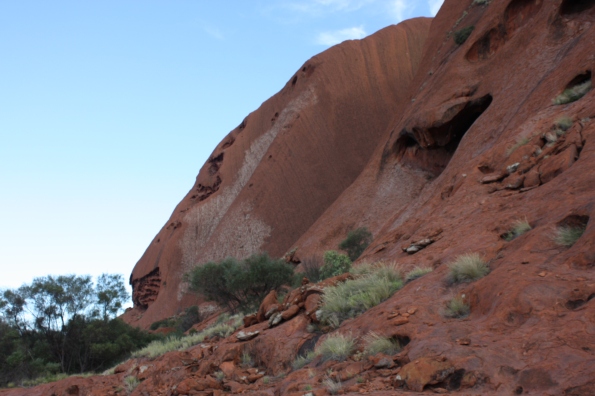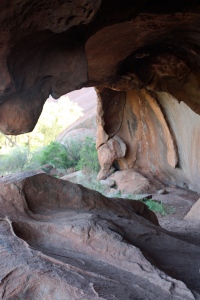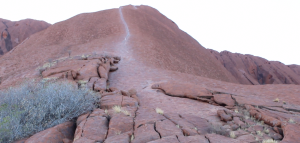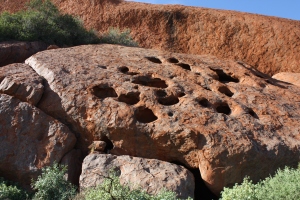Walking the walk at Uluru (Ayers Rock)
There are plenty of ways to get up-close-and-personal with Uluru without climbing it.*
In fact, there are five special tourist walks that each take 90 minutes or less and are deemed to be easy and even wheelchair-friendly. A sixth walk is the full circuit of the rock’s base. That is just over 10 kilometres and takes anywhere from 3 to 5 hours. I’ve done that walk in 4 hours and Poor John has done it in less—me in the year 2000 and him in 2011. It was blisteringly hot both times.
I’ve also done all the other walks, but every time I’ve been to Uluru I’ve managed to do my favourite, the Mala Walk. It starts near the beginning of the actual rock climb, and takes only 45–60 minutes on your own, or up to two hours with an Aboriginal guide. Guides are amazing and they share a wealth of information, but they dawdle. The posted signs are helpful too if you have limited time.
Either way, the walk introduces you to how the rock has been used for centuries.
The Mala Walk ends at the Kantju Gorge, but along the way you see many caves that have historical importance for the Anangu—such as the kitchen cave, the old people’s cave and the teaching cave.
There’s plenty of flora and fauna too. My favourite is the bloodwood tree, which is perfect for making didgeridoos. In case you didn’t know, didges are not hollowed out by hand. Aborigines let termites do the work for them.
Other good walks are the Kuniya Walk, the Lungkata Walk, the Liru Walk and the Dune Walk.
If you ever get to Uluru, you’ll get plenty of brochures and guides for all sorts of activities. Do the walks—any and all of them. And please respect the requests to not photograph or walk by sensitive areas. We are their guests!
If you feel you have to climb, be sure to wear sturdy shoes and take enough water.
As an aside, park entry costs $25 for three days. This price covers Uluru and Kata Tjuta (more about that soon) and the cultural centre. Be sure to visit the centre, but remember that no photos are allowed. Lots of wonderful explanations and great artwork for sale. Don’t miss it!
* To climb or not to climb?
Uluru rises 348 metres (equal to about a 26-storey building) above the surrounding red plains. Thousands of tourists have climbed it since 1958, and more than 35 have died doing so. Many more have been injured.
The climb is closed when it’s too hot, too rainy, too slippery or when there are Aboriginal cultural occasions. It’s open the rest of the time.
I’m not criticising people who do climb. It really is an individual choice.
But you need to know that the Anangu people, traditional owners of the rock, don’t want people to climb. For starters, the rock is extremely sacred to them. It’s plays an important part in their Dreamtime lore.
Plus they say the Anangu suffer when someone dies climbing the rock. It’s rather like having someone fall down dead in your backyard.
I’ve signed an oath that I will never climb. That might have been different if the first time I was there it hadn’t been 45°C (or 113°F).
Pinching (stealing) things from Uluru
It’s very tempting to take things from the Uluru-Kata Tjuta National Park. A bit of rock, a scoop of sand, a twig or more. It doesn’t matter. No one will notice.
But they do notice and you’ll notice too. There’s a sort of visitor’s book in the cultural centre that’s loaded with letters from people sending back bits of rocks and surrounds that they pinched .
Many have suffered a lot of misfortune since taking te bit of rock. They are trying to make amends. So for your own well-being. Don’t take it to begin with. Just saying!






I love going places I know I will never be!
So thanks for the travels through your words, photos and experiences from ME! 🙂
LikeLike
Thanks Joanne. I love being able to share these adventures.
LikeLike